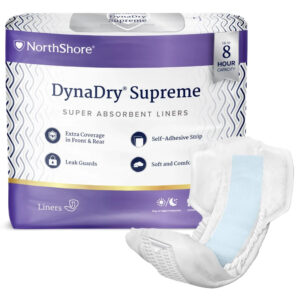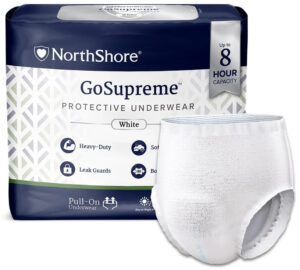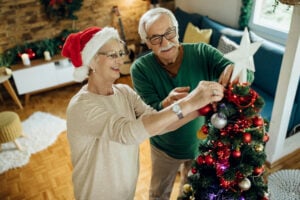By Northshore Care Supply
Incontinence is a common and often challenging condition that affects people of all ages. While you’re sure to see television commercials from store brands whispering about small drips or the occasional wet sneeze, for many people dealing with incontinence losing control can feel more like a flood and less like a dribble. It’s important to recognize that not all instances of incontinence are the same.
Whether you’re dealing with light urinary incontinence or heavy bladder and bowel incontinence, you need to choose the solutions that work best for your specific situation. In this blog article, we will explore the fundamental differences between heavy incontinence and light incontinence and provide recommendations for managing heavy incontinence.
Understanding Incontinence
Before delving into the differences between heavy and light incontinence, let’s clarify what incontinence means. Incontinence is a condition characterized by the loss of bladder or bowel control, resulting in involuntary leakage of urine or feces. It can affect people of all ages, although it is more prevalent among older adults.
The condition has many causes and variations. An assessment by a medical professional is necessary to determine the type of incontinence and severity. Such an evaluation is usually conducted by a urologist who specializes in conditions relating to the bladder, urethra, ureters, kidneys and adrenal glands. Typically, incontinence will be categorized as light, moderate, or heavy, depending on the frequency and volume of leakage.
Light Incontinence
The most common type of incontinence is stress incontinence. These are small leaks caused by physical exertion. Stress incontinence leaks may occur when pressure — or stress — is put on the bladder, such as when coughing or sneezing, lifting something heavy, exercising or bending over. As many as 1 in 3 women experience stress incontinence during their lifetime. Men are affected as well, but not as often. In men, stress incontinence can occur after prostate cancer treatment, while in women it is usually experienced after childbirth or menopause.
Key Characteristics of Light Incontinence
- Occasional Leakage: Leaks are minor and sporadic, usually brought on during specific activities
- Minimal Volume: The amount of urine leaked is generally small
- Common Triggers: Leaks brought on by stress activities like coughing, sneezing, laughing, or exercise
There are many options for managing and treating light stress incontinence. First, it’s important to speak to your doctor. Avoiding or delaying treatment may increase the severity of the issue. For many, incontinence can be difficult to discuss, and individuals with light incontinence may think the occasional small leak is nothing to worry about and will go away with time, or they believe it is a normal part of aging. Incontinence is not normal, but it is very common, often treatable, and extremely manageable, so don’t hesitate to seek professional help from your healthcare provider. Your doctor may recommend pelvic floor exercises, lifestyle modifications, or incontinence pads.
When choosing products for light incontinence be sure to choose a pad or liner designed for incontinence rather than a menstrual pad. Because many women are used to menstrual pads, it’s easy to assume they’re acceptable for mild incontinence protection as well, but incontinence products aren’t interchangeable with feminine hygiene supplies.
Heavy Incontinence
If you’ve been experiencing more than the occasional minor leak, you may be dealing with moderate to heavy incontinence. Heavy incontinence, also known as severe or total incontinence, represents a more challenging and persistent form of the condition.
Key Characteristics of Heavy Incontinence
- Frequent & Substantial Leakage: Heavy incontinence involves recurring leaks or voids throughout the day, may include urinary and bowel voids
- Day & Night Leaks: Loss of control may occur during the day, and at night leading to interrupted sleep
- Limited Control: Those with heavy incontinence can have limited control over their bladder, resulting in higher risk of accidents
Managing Heavy Incontinence
Heavy incontinence can be disruptive to daily life. It may necessitate frequent changes, disrupt sleep, and lead to emotional and psychological challenges. Fear of leaks, odors, and embarrassment can keep many with heavy incontinence stuck at home, isolated from friends and family. It’s important to remember that even heavy incontinence can be managed successfully and that there are treatment options.
Absorbent products can be an immediate way to manage heavy incontinence, while you wait for a doctor’s appointment and explore your treatment options. There are a variety of absorbent products available including:
- Incontinence Pads, Liners, and Guards: Adhesive pad stuck into your existing washable underwear to absorb leaks, some heavy absorbency options exist, but pads are usually best for light incontinence.

- Pull-on Style Absorbent Underwear: Pull on and off like traditional underwear but include an absorbent core. Usually made of a breathable cloth-like material that stretches to fit your body.

- Diaper-Style Briefs with Tabs: Tab-style briefs benefit people looking for a more secure fit. Tabs give a tighter fit around the leg area and allow you to tighten the product throughout the day to prevent sagging after multiple voids.

You can find absorbent products at your local pharmacy, home medical equipment store, or you can order discreetly online via an online retailer. Local retail stores tend to cater toward light incontinence, so if you’re experiencing heavy incontinence an online retailer will usually have a larger selection and more options with higher absorbencies so you can change your products less frequently. NorthShore Care Supply offers premium, maximum absorbency products along with convenient, discreet home delivery. NorthShore brands offer up to 3x the leak protection of retail brands.
Many people tend to start with the lightest product and work their way up when dealing with incontinence, but if you’re experiencing heavy incontinence, you’ll likely want to start with pull-up underwear or an adult diaper. These products will offer protection for more than one void, allowing you to avoid frequent changes and get back to your daily routine. Remember to be patient with yourself. Using adult diapers can be a new and unfamiliar experience, but with a little practice you’ll get the hang of it in no time.
It may take some time to effectively manage incontinence, but don’t give up hope. Everyone experiencing incontinence deserves to live their life to the fullest with freedom and dignity. Whether you’re dealing with the occasional leak or heavy control problems, there are products and treatments available.
Learn more about NorthShore Care Supply and our mission to help individuals manage incontinence with life-changing products and initiatives.
About Northshore Care Supply
NorthShore was founded in 2002 to empower people to live with the freedom and dignity they deserve and has helped over 2.5 million families keep their loved ones protected from leaks. The company is committed to helping 80 million Americans manage bladder or bowel incontinence, especially those with the heaviest control problems. Our featured NorthShore® brand is the leading premium adult diaper brand in the U.S. and is available at NorthShore.com or by calling (800) 563-0161. Follow us on LinkedIn, Facebook, Twitter, and Instagram.







One Response
I’m very new to this world…and I’m finding some problems with the learning curve in reference to products intended to help me. Because of my build and very small genitals I’ve found that products intended for women seem to work best. Is this common or am I missing something?